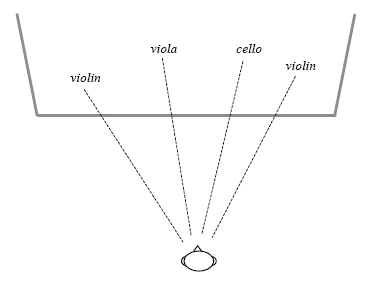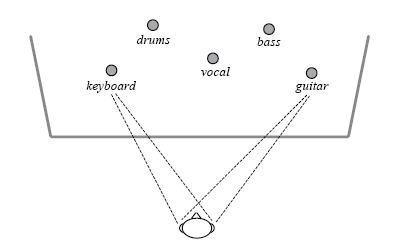Localization Spaciousness Reverberation
|
This article is an editorial and expresses the opinion and experience of Hilmar-at-Bose the author. Please post comments in the discussion page.
|
Originally posted by Hilmar-at-Bose
[1]
There may be some confusion about “localization” and “spaciousness”. Both are perceptual attributes, which have been intensively studied especially in the context of concert hall acoustics.
"Localization" refers to your ability to detect the direction of a specific sound source. Let’s say you have your eyes closed but you can immediately tell where the guitar is (as opposed to the bass or the violin).
"Spaciousness" refers to the perceived size of the sound source and how much you feel enveloped with sound. Most researchers believe that a “good” concert hall provides both: accurate and easy localization and a sufficient amount of spaciousness.
The main contributing factors for spaciousness are “early lateral reflections”. These are reflections from the sidewalls. Reflections from the side help quite a bit with creating a sense of space and envelopment. Reflection from the floor and ceiling are less desirable since they don’t enhance spaciousness but can negatively impact clarity and spectral balance. There are very interesting physiological reasons of why lateral reflections are perceived so much differently than vertical ones. I could drone on for hours on this topic, but I’ll save that for later. Anyway, it’s not too much of a surprise that most renowned concert halls (e.g. Musikvereinssaal in Vienna, Concertgebow in Amsterdam, or Boston Symphony Hall) have a “shoebox” shape that is long, narrow and tall. This shape provides good lateral reflections pretty much everywhere in the audience. Ironically, it’s not very popular with architects since the sight lines are terrible. Visually oriented architects prefer the “shell” shape, which provides great viewing but (unfortunately) no lateral reflections whatsoever. But I’m digressing again… The L1 does (in my humble opinion) the best thing. It radiates very wide horizontally but very little much towards the ceiling. Thus it provides enough energy for lateral reflections but keeps interfering ceiling reflections at bay. Since it’s a single source, it provides very easy and accurate localization, but in most venues the image will also be pleasantly spacious. That’s at least my own experience. - read it in context[1]
Originally posted by Ken-at-Bose [2] (later in the same discussion):
What we perceive as "reverberance" is caused physically almost entirely by the persistence in time of an acoustic event.
Spaciousness -- the feeling of envelopment and room size is different.
Localization -- where we perceive the sound to be coming from -- is different again.
Localization is almost entirely determined by the direction of the first arrival of sound (almost always the direct sound from the speaker in this case) and thus is almost entirely immune from the effects of reflections. Spaciousness is heavily determined by lateral reflections, which are produced in relative abundance by the L1 because it's so wide in its pattern.
High reverberance is caused by lots of reflections in rooms with little absorption. The L1 is particularly good at NOT producing as much reverberance because it sends little sound to the upper walls and ceiling where many detrimental reflections originate and are perpetuated.
Cocktail Party Effect
The following incorporates two excerpts from "Applying the Benefits of Unamplified Acoustic Music to Performances with Amplification" - pages 11 and 51[3]
Unamplified performances
- In an unamplified musical performance, a rich and diverse sound field is created by the arrangement in space of the players and their instruments. Musicians and members of the audience hear the sound of each instrument coming from a different direction, and this direction corresponds naturally to what they see.
- In unamplified performances, regardless of where the listener is located, sound is heard coming from the directions of the individual instruments – directions that furthermore correspond to what is seen.
- The perceptual benefit of having sound from sources in a multi-source environment come from different directions has been extensively studied in the field of psychoacoustics and is known there as the cocktail party effect.2 Other studies show the significant benefit that comes from being able to see and hear a source at the same time, a benefit of special importance in a multi-source environment.3
Fundamental advantages of the new approach
- The advantages of the approach based on the Cylindrical Radiator™ loudspeaker are comprehensive because both the primary and secondary problems characteristic of the triple-system approach are addressed.
- 1. Full use of the property of hearing known as the cocktail party effect
- In the audience and on stage, regardless of location, the sound of each instrument or voice comes from a different direction. Thus the full spatial richness present in an unamplified performance is achieved. The full benefit of the cocktail party effect – the ability to pick out and appreciate individual instruments and voices because they are coming from different directions – is enjoyed by musicians and members of the audience.
- In the approach using Cylindrical Radiator loudspeakers described here, the listener hears sound from the locations of each of the individual instruments, as in an unamplified performance.


